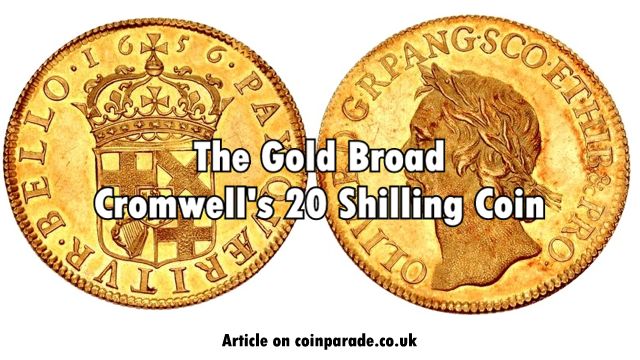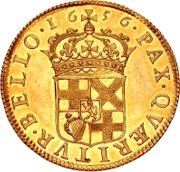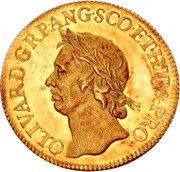
Home | Miscellaneous | 1656 Gold Broad (20 shillings) - Oliver Cromwell
 The 1656 Gold Broad (20 shillings) - Oliver Cromwell
The 1656 Gold Broad (20 shillings) - Oliver CromwellThe Gold Broad was only issued in 1656 and was denominated as 20 shillings, marking it as an ancestor of the guinea and sovereign. It has a diameter of 29 or 30mm and a weight of 9.0 to 9.1g. It was designed by Thomas Simon, who was apparently also known as Thomas Symonds.
The Broad was struck in Blondeau's Mint, Drury House, London. Peter (Pierre) Blondeau was a French Moneyer (a private individual who is officially permitted to mint money). Blondeau produced milled coinage and invented new techniques to make coins, such as edge lettering. This didn't always go well with other English Moneyers that worked for the Mint and the fear of reprisal was the reason Blondeau moved to Drury House as the Tower Mint couldn't guarantee the security of his machines. Cromwell was a big fan of Blondeau but when Cromwell died in 1658, Blondeau thought it safer to move back to France.
The Reverse shows the Crowned Shield of the Protectorate, showing the arms of the Commonwealth. The inscription "PAX QVAERITVR BELLO" means "Peace is sought through war". Dated 1656.
The Obverse shows a Laureated bust of Oliver Cromwell. The legend is "OLIVAR D G R P ANG SCO HIB &c PRO" meaning "Oliver, by the Grace of God, of the Republic of England, Scotland, Ireland etc., Protector".
 The Gold Broad is an expensive coin, and may cost over £30,000.
The Gold Broad is an expensive coin, and may cost over £30,000.There is a Piedfort version of the Broad denominated at 50 shillings. There is also half-broad but this may have been struck much later than the 1656 date. Both are rare.
Image credit: CNGCoins
Mintage: Not known
Minted at The Royal Mint
More information (monarch, year, mint, country, category) can be found below coin listings.
Below are some coins currently being offered on eBay. As an eBay Partner, We may be compensated if you make a purchase.
List items on:
 | 1/200 oz Coin Gold 999, Gold Broad Oliver Cromwell 1656, 2023 (00052) £ 39.99 |
 | Retro Oliver Cromwell 1656 Broad (Twenty Shillings). Souvenir Gap Filler. £ 4.45 |
List items on:
Remember 1656 ?
No Monarch. Oliver Cromwell is Lord Protector and the parliament is the Second Protectorate. Anglo-Spanish war continues. The only English fifty shilling coin is minted.
Oliver Cromwell / Commonwealth (1649-1660)
Oliver Cromwell was not a Monarch but an English military and political leader and later Lord Protector of the Commonwealth of England, Scotland, and Ireland. As such his name did appear on coins. The actual monarch was Charles I, whom Cromwell was key in having executed.Cromwell was an MP but after one year King Charles didn't recall Parliament for nearly 11 years. Eventually the chasm between King and Parliament led to a Civil War. Oliver Cromwell was a talented military leader and won several battles with the Royalists, eventually defeating them and putting the King on trial leading to Charles I being put to death.
Cromwell as Protectorate (1653-1658) was a controversial figure. He deposed the Monarchy yet replaced it with his own ruthless, tyrannical rule. He signed himself 'Oliver P' (P for Protector) as in the style of Monarchs; he was referred to as 'his majesty' and paid himself £100,000 per year, which was a lot of money in the 1650s.
He was offered the Crown for the Monarchy in 1657 to help get stability back to the country, but eventually turned it down. After a short illness in 1658 he died, and his son Richard became Lord Protector but that didn't last long and Richard resigned in 1659. The monarchy was restored in 1660 when Charles II returned from exile. Oliver Cromwell's body (or what they thought was his body) was exhumed and posthumously executed.
Also in this category are 'Commonwealth' coins. These were issued between 1649 and 1660. They had no portraits, instead showing the Cross of St George and the Harp of Ireland. The inscriptions were in English rather than Latin so not as to be seen as associating with the Catholic Church. The Commonwealth coins often carried mint marks: 1649-57 was a Sun, and 1658-1660 was an Anchor. The anchor shows the protectorship was that of Richard Cromwell, Oliver's son.
Category: Miscellaneous
We created this category to show coins which don't have their own group, maybe because they are unique or rare, or just that we don't have enough images to justify their own group. Not necessarily expensive, some just too interesting not to list!Which Mint: The Royal Mint
The Royal Mint is the designated place for the UK to mint coins. It dates back well over 1000 years and is a Government-owned company. Formed in the reign of Alfred the Great about the year 886, during the period 1279-1812 it was generally referred to as The Tower Mint as it was housed at the Tower of London. The Master of The Royal Mint has included famous figures such as Sir Isaac Newton.
Since 2010 it has operated as Royal Mint Ltd, a company owned by HM Treasury, under an exclusive contract to supply all coinage for the UK although it also produces medals and coins for other countries. It is currently located at Llantrisant, Wales.
Country of Origin: United Kingdom
The United Kingdom (UK) is the Union of England, Scotland, Wales and Northern Ireland. It is often refered to as Great Britain (GBR). It has a long, rich history. The orignal coinage was Pounds, Shillings and Pence but since decimalisation on 15 February 1971, it is £1 = 100p, that is One Pound = 100 pence. The coinage of the UK is also a long history, the Royal Mint being established as long ago as 886AD when coins were hammered. Today there is perhaps 30 billion coins in circulation, and many (numismatic) collectors coins and sets are issued frequently in gold, silver and other metals.
Try the Miscellaneous page on eBay UK
As an eBay Partner, We may be compensated if you make a purchase.
As an eBay Partner, We may be compensated if you make a purchase.
